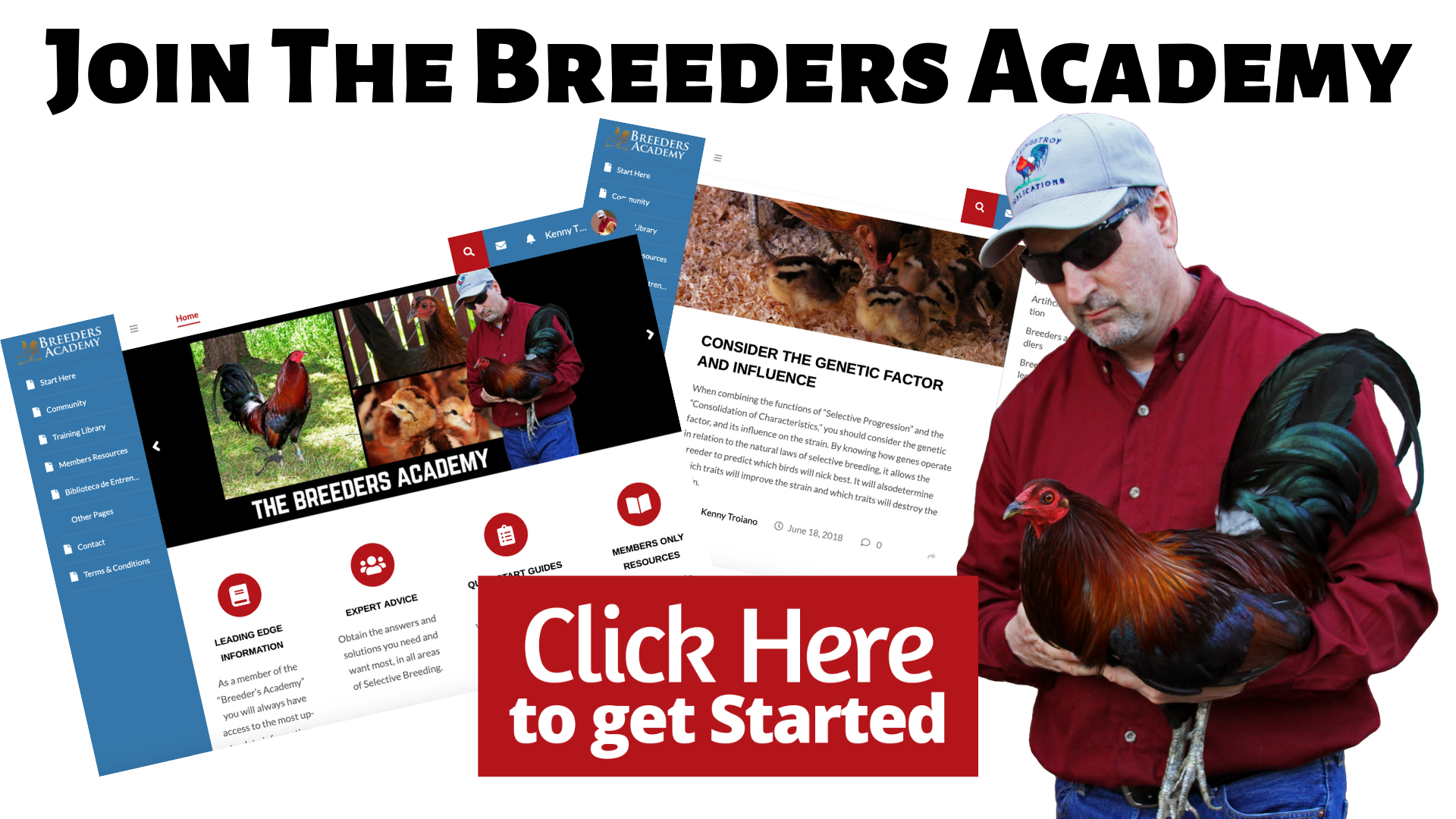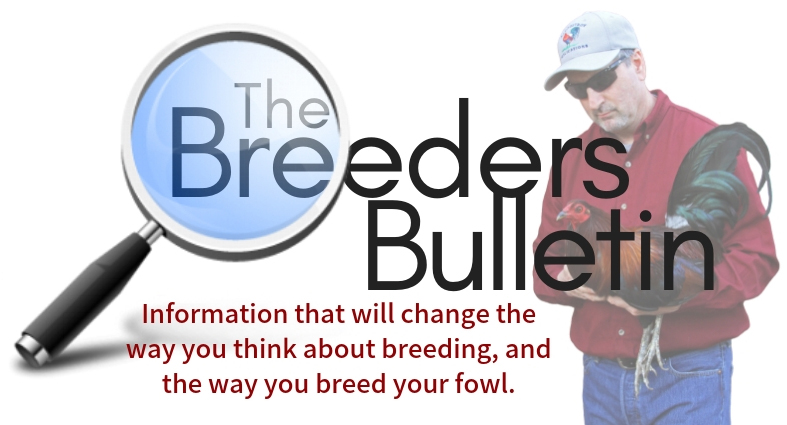By Kenny Troiano
Copyright©2020 by Kenny Troiano/Maximus Troy Publications
 Many believe they are breeders, but don’t know the first thing about breeding: Its funny, but I see this all the time, online, especially in the forums. Those with very little experience and knowledge acting like breeding experts. The truth is, only a small percentage of those who breed fowl know what they are doing. To make matters worse, the percentage drops considerably when you include Master Breeders. With such a discrepancy, as to who the real breeders are, there is no wonder we have confusion within our ranks.
Many believe they are breeders, but don’t know the first thing about breeding: Its funny, but I see this all the time, online, especially in the forums. Those with very little experience and knowledge acting like breeding experts. The truth is, only a small percentage of those who breed fowl know what they are doing. To make matters worse, the percentage drops considerably when you include Master Breeders. With such a discrepancy, as to who the real breeders are, there is no wonder we have confusion within our ranks.
We begin with the Master Breeders: These are breeders who are dedicated to their craft, in this case, the perpetuation of high quality, high performance strains. They put all their time and effort into learning everything possible about breeding, including genetics, health care and disease prevention, and nutrition (including feedstuffs and supplements), and good farm management practices. They apply what they have learned, in order to achieve a specific result, striving ever closer towards perfection with every breeding.
It is because of this devotion to perfection that they have proven their worth and achieved a definite level of authority amongst their peers. These breeders are important because they not only maintain their chosen breeds, but they create specialize strains with the ability to progress the breed, as a whole, for future generations, and they show others how to do the same. These breeders are known as the experts in our field, and account for less than 1% of all breeders.
Then we have the apprentices. These breeders are important because of their willingness to learn what it takes to breed and raise great fowl. Some read books, while others search for good mentors. These are the beginners, or Amateurs Breeders in our field, and account for about 14% of all the breeders.
And then there’s the “85 Percenters”: It’s interesting, but once you get past the Master Breeder and Apprentices, the quality of breeder drops considerably. This is a bit unsettling, for the fact that the majority of all breeders don’t know what they are doing. In fact, these are individuals who know nothing about breeding, but think they are breeders. They neither read nor search out good mentors. Instead, they follow their friends, who in most cases, depend on “old wives tales” and “superstitions,” guesswork, speculation, and random or chance experimentations. These individuals account for a whopping 65% of all breeders.
The fact is, there is a big difference between someone who operates through guesswork and someone who uses well thought-out theory’s based on scientific knowledge and proven breeding principles. One has no foundation or system to follow, while the other is methodical and systematic. One operates by chance or trial and error, while the other is guided by science.
What about the other 20 percent?The other 20% or so, that produce fowl each year, are those who do it unintentionally, or by accident. These breeders contribute to the breed, but not in a beneficial way. The fowl they produce could trickle into our established bloodlines and by doing so they introduce traits that don’t belong. Although they only account for 20% of all breeders, and only 1% of the fowl they produce ever make it into the mainstream, they could have a devastating influence on the breed as a whole. I admit that the percentage is low, however, all it takes is the introduction of one bad trait to ruin a strain.
How do we improve the 85 Percentors?It is important for every breeder to know their breed, and the ancestry of every bird on their farm, and have an understanding about the art of selective breeding before they begin breeding. This is where the 85 Percentors fail.
I would place the lower 85% into four separate categories – “the ignorant breeder,” “the neglectful breeder,” “the mixer,” and “the accidental breeder.” Let’s discuss them now:
- The first type is what I call “the ignorant breeder.”They will select and breed a cock to a hen, but will not take the time to learn the basics, such as genetics, breeding methods and record keeping. They don’t understand the breed or their structure and makeup, so they don’t know which traits are important and which traits should be culled. They have a general idea of the proper conformation of body and color of plumage, but they are unaware of the defects that are common with that breed. In short, they have no idea how to improve and maintain the breed. These breeders tend to move towards the crossbreeding category because they fail to get the desired results and become discouraged with the status quo.
- The second type is what I call “the neglectful breeder.”They will concentrate their effort on a particular trait, but will neglect traits that are extremely important. Or they will select a bird, that looks great overall, but expresses a serous defect. They select traits, with the hope of improving the strain, but they don’t cull traits that are harmful to the future of that strain.
- The third type, I call “the mixer.”These breeders use crossbreeding as their main method of breeding. They resist any and all methods used to create, improve, and maintain strains. They gravitate towards the quick and easy method for producing fowl. If you were to ask them what they thought of creating and maintaining pure lines or families, they would tell you there is no such thing as pure. These breeders prefer quantity above quality. You will also find that these breeders tend to drift towards “superstitions” and “old wives tales.” Breeders, such as these, are easy to identify by the number of breeds or strains that they raise. I would stay clear of anybody that breeds and raises more than three strains. Peddlers fall into this category.
- The fourth type is “the accidental breeder.”These individuals raise fowl, but for the joy of having some birds around the house. They don’t have any aspirations to maintain a strain or to produce offspring. However, the offspring that are produced, due to a lack of flock management practices, are accidental. The fowl these individuals produce can have devastating effects on the breed, because they find their way into the system (other breeders’ bloodlines), but are not standard bred.
So, where do you fit it to the over scheme of things? I hope this article will inspire you to becoming a true breeder, and to select the right breeder when buying your first breeding trio or brood fowl.
Thanks for reading
Join us at the Breeders Academy,
and make sure to listen to our podcast, “Bred to Perfection, and subscribe to our newsletter, “The Breeders Bulletins.”
Kenny Troiano

